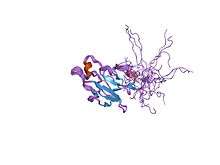Forkhead-associated domain
| FHA domain | |||||||||
|---|---|---|---|---|---|---|---|---|---|
 solution structure of the fha domain of human ubiquitin ligase protein rnf8 | |||||||||
| Identifiers | |||||||||
| Symbol | FHA | ||||||||
| Pfam | PF00498 | ||||||||
| Pfam clan | CL0357 | ||||||||
| InterPro | IPR000253 | ||||||||
| PROSITE | PDOC50006 | ||||||||
| SCOP | 1qu5 | ||||||||
| SUPERFAMILY | 1qu5 | ||||||||
| |||||||||
In molecular biology, the forkhead-associated domain (FHA domain) is a phosphopeptide recognition domain found in many regulatory proteins.[1] It displays specificity for phosphothreonine-containing epitopes but will also recognise phosphotyrosine with relatively high affinity. It spans approximately 80-100 amino acid residues folded into an 11-stranded beta sandwich, which sometimes contains small helical insertions between the loops connecting the strands.[2]
To date, genes encoding FHA-containing proteins have been identified in eubacterial and eukaryotic but not archaeal genomes. The domain is present in a diverse range of proteins, such as kinases, phosphatases, kinesins, transcription factors, RNA-binding proteins and metabolic enzymes which partake in many different cellular processes - DNA repair, signal transduction, vesicular transport and protein degradation are just a few examples.
References
- ↑ Hofmann K, Bucher P (September 1995). "The FHA domain: a putative nuclear signalling domain found in protein kinases and transcription factors". Trends Biochem. Sci. 20 (9): 347–9. doi:10.1016/S0968-0004(00)89072-6. PMID 7482699.
- ↑ Durocher D, Jackson SP (February 2002). "The FHA domain". FEBS Lett. 513 (1): 58–66. doi:10.1016/S0014-5793(01)03294-X. PMID 11911881.
External links
- Eukaryotic Linear Motif resource motif class LIG_FHA_1
- Eukaryotic Linear Motif resource motif class LIG_FHA_2
This article incorporates text from the public domain Pfam and InterPro IPR000253